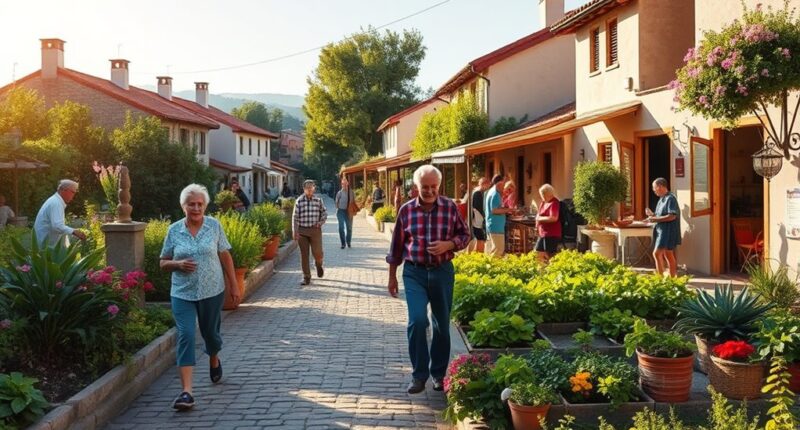Blue Zones are areas where people live longer, healthier lives thanks to specific habits. You’ll find they focus on eating mostly plant-based foods, practicing moderation, and sharing meals with family and friends. Community involvement and strong social bonds also play a big role in their longevity. These habits work together to promote well-being and purpose. If you continue exploring, you’ll discover how these principles can inspire your own journey to better health and longer life.
Key Takeaways
- Blue Zones are regions with populations that live significantly longer and healthier lives, due to unique lifestyle habits.
- Their diets focus on plant-based foods, moderation, and social eating, promoting overall health and longevity.
- Strong social connections and community involvement are core factors that support emotional resilience and well-being.
- The interplay of shared meals and social bonds reinforces healthy habits and a sense of purpose.
- Emulating Blue Zone habits—balanced diets and meaningful relationships—can enhance lifespan and quality of life.

Blue Zones are regions around the world where people live markedly longer and healthier lives than average. When you explore these areas, you’ll notice that certain habits set these communities apart, especially their dietary patterns and social connections. These elements aren’t just about what people eat or who they spend time with—they’re deeply woven into their daily routines and cultural values, shaping a lifestyle that promotes longevity.
Blue Zones thrive on community, balanced diets, and lifelong habits that foster longevity and well-being.
Your dietary patterns in Blue Zones tend to emphasize whole, plant-based foods. Think of meals rich in vegetables, legumes, nuts, and whole grains, with meat and processed foods playing a minimal role. These communities often practice moderation, eating until they’re about 80% full, which helps prevent overeating and supports better digestion. It’s not about strict dieting but rather about consistency and balance. Incorporating more plant-based foods into your diet can improve your overall health, reducing the risk of chronic diseases and increasing longevity. Additionally, many Blue Zone inhabitants enjoy their meals as social events, turning eating into a shared experience rather than a solitary or rushed activity. This practice fosters stronger social bonds and makes healthy eating more sustainable.
Speaking of social bonds, social connections are an essential part of life in Blue Zones. You’ll find that these communities prioritize family, friendships, and community involvement. Regular interactions with loved ones and neighbors create a support network that encourages healthier behaviors and provides emotional resilience. When you’re socially engaged, you’re more likely to adopt positive habits, stay active, and manage stress effectively—all factors that contribute to a longer life. These communities often have a sense of purpose and belonging, which research shows can add years to your life. Maintaining strong social ties isn’t just about having people around; it’s about meaningful relationships that give you a sense of purpose and joy.
In Blue Zones, social connections and dietary patterns work hand in hand. Shared meals and communal activities reinforce healthy habits while fostering feelings of belonging and purpose. If you want to emulate these longevity-promoting habits, focus on cultivating meaningful relationships and adopting a balanced, plant-centric diet. It’s not about perfection but consistency—small daily choices that, over time, can make a significant difference in your health and lifespan. Integrating these principles into your life creates a supportive environment that encourages lasting health and well-being.
Frequently Asked Questions
How Can I Incorporate Blue Zone Habits Into Urban Living?
To incorporate Blue Zone habits into urban living, start by practicing urban gardening to grow fresh, healthy food and boost your well-being. Engage with your community by participating in local events or creating neighbor groups focused on health and sustainability. These habits promote social connections and a healthier lifestyle, mirroring Blue Zone principles. Small steps like these can help you embrace longevity-supporting practices right in your city environment.
Are Blue Zone Practices Effective for Children and Teenagers?
Imagine a Victorian child playing outdoors—blue zone practices can be equally effective today. For children and teenagers, focusing on healthy childhood nutrition and encouraging regular teenage activity helps instill lifelong habits. These practices promote physical and mental well-being, reducing risks of chronic disease. By fostering community bonds and balanced diets, you set a foundation for a healthier, longer life, proving blue zone habits work across all ages.
What Role Does Genetics Play in Longevity Within Blue Zones?
Genetics do play a role in longevity, but they aren’t the whole story. Your genetic predispositions and inherited traits can influence how long you live, but lifestyle choices often have a bigger impact. In Blue Zones, people tend to prioritize healthy habits that can offset genetic risks. So, while your genes matter, focusing on diet, activity, and social connections can help you live a longer, healthier life.
Can Blue Zone Strategies Be Adapted for Different Cultural Backgrounds?
You can adapt Blue Zone strategies for different cultural backgrounds through cultural adaptation and lifestyle customization. By understanding local traditions, food preferences, and social norms, you tailor healthy habits that resonate personally. This approach guarantees that sustainable changes fit seamlessly into your daily life, making longevity strategies more effective. Embracing cultural differences allows you to create a personalized plan that promotes health and well-being, regardless of your community’s unique customs.
How Do Blue Zones Communities Handle Healthcare and Medical Access?
Like a sturdy bridge supporting a long, winding journey, healthcare infrastructure in Blue Zones communities guarantees medical accessibility for all. They prioritize local clinics, community health programs, and affordable care, making health services a reliable part of daily life. This approach fosters trust and early intervention, helping residents maintain wellness. You’ll find that strong healthcare systems form the backbone of their longevity, allowing people to thrive well into their advanced years.
Conclusion
By embracing the habits of Blue Zones, you can boost your longevity and happiness, proving that living well isn’t just a modern trend but a timeless pursuit. Remember, even as you scroll through your feeds, the secrets lie in simple, lasting habits—like eating well, staying active, and nurturing connections. It’s like finding a hidden treasure map, reminding you that the true fountain of youth has always been within your reach, waiting for you to unearth it.









